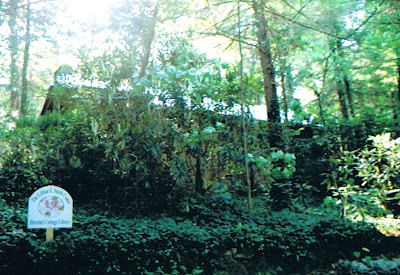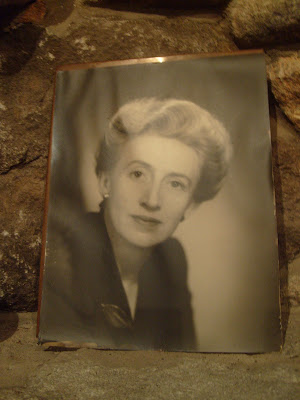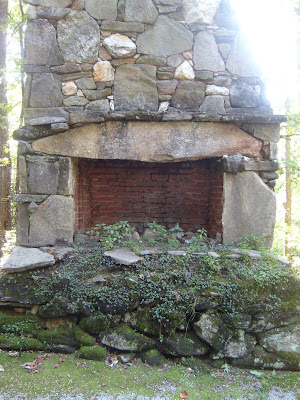The Lillian E. Smith Center for Creative Arts is not too easy to find if you're coming from Clayton town, as it's on the other side of the road, and the entrance is a narrow gravel path leading up Old Screamer Mountain. However, the drive may be very slow, but it's very short and very well worth the effort.
 The Director is Dr Nancy Smith Fichter, Lillian Smith's niece, who lives in Smith's former home with her husband Robert Fichter. The front of the building is generally obscured by vegetation, but the other two photos below give a better idea of what the building looks like. The properties here – or rather what is left of them when some were destroyed by arson – in the 1920s through the 1940s, were part of Laurel Falls Camp for Girls. Smith spent most of her life here.
The Director is Dr Nancy Smith Fichter, Lillian Smith's niece, who lives in Smith's former home with her husband Robert Fichter. The front of the building is generally obscured by vegetation, but the other two photos below give a better idea of what the building looks like. The properties here – or rather what is left of them when some were destroyed by arson – in the 1920s through the 1940s, were part of Laurel Falls Camp for Girls. Smith spent most of her life here.
Lillian Eugenia Smith was born in 1897 in Jasper, Florida, close to the border with Georgia. Her father Calvin was a successful wholesaler of lumber and naval goods, until the business failed in 1915, and the family relocated to Old Screamer Mountain, where the family had a summer home, and where Calvin opened an inn named Laurel Falls Hotel.
Lillian gained a teaching certificate, and studied music in Baltimore. Following a little teaching experience, she took a post as head of the music department in a missionary school in Huchow, Chekiang, China, in 1922 for three years. She described her experience there as 'intense and profound' (Anne C. Loveland, Lillian Smith: A Southerner Confronting the South: A Biography, Baton Rouge: Louisiana State University Press, 1986, p. 11).
Lillian's parents were ill and not in a very good financial position on her return in 1925. In 1920 Calvin had made the hotel into a girls' camp, and Lillian had worked there before going to China, and although she had not liked it she felt the need to take control of it. Over the years, Lillian transformed Laurel Falls Camp, and strove to spread her ideas against competition and racial prejudice.


 A slightly blurred library, or rather the mantelpiece of it. This was an extension to Lillian Smith's living quarters.
A slightly blurred library, or rather the mantelpiece of it. This was an extension to Lillian Smith's living quarters.

 The photos of a young and an older Lillian Smith on the mantelpiece.
The photos of a young and an older Lillian Smith on the mantelpiece.
 Nancy Smith Fichter on the sofa in front of one of the library walls.
Nancy Smith Fichter on the sofa in front of one of the library walls.
 A detail from the Lillian E. Smith house museum.
A detail from the Lillian E. Smith house museum.
 A slightly blurred common room, which was formerly the camp craft shop.
A slightly blurred common room, which was formerly the camp craft shop.
 The kitchen through the common room.
The kitchen through the common room.
 A momento from China hanging in the kitchen.
A momento from China hanging in the kitchen.
 The chimney from 'The Playhouse': all that remains of the camp theatre after the arson attack, and now Lillian Smith's gravesite.
The chimney from 'The Playhouse': all that remains of the camp theatre after the arson attack, and now Lillian Smith's gravesite.
 A closer view of the chimney.
A closer view of the chimney.
 The plaque on the grave: 'Lillian Smith December 12, 1897 - September 28, 1966. "Death can kill a man; that is all it can do to him: It cannot end his life. Because of memory..."'
The plaque on the grave: 'Lillian Smith December 12, 1897 - September 28, 1966. "Death can kill a man; that is all it can do to him: It cannot end his life. Because of memory..."'
 Smith's novel Strange Fruit (1944), which takes its name from the Billie Holiday song about the lynching of a black man. The novel, which involves the sexual relationship between a young white man and a young girl, was banned in Boston, and the postal service refused to send copies out until Eleanor Roosvelt intervened. Smith was a tireless worker for human rights, and many of her opinions relating to this are given in her Killers of the Dream (1949).
Smith's novel Strange Fruit (1944), which takes its name from the Billie Holiday song about the lynching of a black man. The novel, which involves the sexual relationship between a young white man and a young girl, was banned in Boston, and the postal service refused to send copies out until Eleanor Roosvelt intervened. Smith was a tireless worker for human rights, and many of her opinions relating to this are given in her Killers of the Dream (1949).
 As with Strange Fruit, I bought this book from Prater's Main Street Books in downtown Clayton. (I also bought a book on the life and poetry of 'Mountain Singer' Byron Herbert Reece, about whom I'd not heard at all, but that's another story.)
As with Strange Fruit, I bought this book from Prater's Main Street Books in downtown Clayton. (I also bought a book on the life and poetry of 'Mountain Singer' Byron Herbert Reece, about whom I'd not heard at all, but that's another story.)
Many thanks to Nancy Smith Fichter and Robert Fichter for their hospitality.
 The Director is Dr Nancy Smith Fichter, Lillian Smith's niece, who lives in Smith's former home with her husband Robert Fichter. The front of the building is generally obscured by vegetation, but the other two photos below give a better idea of what the building looks like. The properties here – or rather what is left of them when some were destroyed by arson – in the 1920s through the 1940s, were part of Laurel Falls Camp for Girls. Smith spent most of her life here.
The Director is Dr Nancy Smith Fichter, Lillian Smith's niece, who lives in Smith's former home with her husband Robert Fichter. The front of the building is generally obscured by vegetation, but the other two photos below give a better idea of what the building looks like. The properties here – or rather what is left of them when some were destroyed by arson – in the 1920s through the 1940s, were part of Laurel Falls Camp for Girls. Smith spent most of her life here.Lillian Eugenia Smith was born in 1897 in Jasper, Florida, close to the border with Georgia. Her father Calvin was a successful wholesaler of lumber and naval goods, until the business failed in 1915, and the family relocated to Old Screamer Mountain, where the family had a summer home, and where Calvin opened an inn named Laurel Falls Hotel.
Lillian gained a teaching certificate, and studied music in Baltimore. Following a little teaching experience, she took a post as head of the music department in a missionary school in Huchow, Chekiang, China, in 1922 for three years. She described her experience there as 'intense and profound' (Anne C. Loveland, Lillian Smith: A Southerner Confronting the South: A Biography, Baton Rouge: Louisiana State University Press, 1986, p. 11).
Lillian's parents were ill and not in a very good financial position on her return in 1925. In 1920 Calvin had made the hotel into a girls' camp, and Lillian had worked there before going to China, and although she had not liked it she felt the need to take control of it. Over the years, Lillian transformed Laurel Falls Camp, and strove to spread her ideas against competition and racial prejudice.


 A slightly blurred library, or rather the mantelpiece of it. This was an extension to Lillian Smith's living quarters.
A slightly blurred library, or rather the mantelpiece of it. This was an extension to Lillian Smith's living quarters.
 The photos of a young and an older Lillian Smith on the mantelpiece.
The photos of a young and an older Lillian Smith on the mantelpiece. Nancy Smith Fichter on the sofa in front of one of the library walls.
Nancy Smith Fichter on the sofa in front of one of the library walls. A detail from the Lillian E. Smith house museum.
A detail from the Lillian E. Smith house museum. A slightly blurred common room, which was formerly the camp craft shop.
A slightly blurred common room, which was formerly the camp craft shop. The kitchen through the common room.
The kitchen through the common room. A momento from China hanging in the kitchen.
A momento from China hanging in the kitchen. The chimney from 'The Playhouse': all that remains of the camp theatre after the arson attack, and now Lillian Smith's gravesite.
The chimney from 'The Playhouse': all that remains of the camp theatre after the arson attack, and now Lillian Smith's gravesite. A closer view of the chimney.
A closer view of the chimney. The plaque on the grave: 'Lillian Smith December 12, 1897 - September 28, 1966. "Death can kill a man; that is all it can do to him: It cannot end his life. Because of memory..."'
The plaque on the grave: 'Lillian Smith December 12, 1897 - September 28, 1966. "Death can kill a man; that is all it can do to him: It cannot end his life. Because of memory..."' Smith's novel Strange Fruit (1944), which takes its name from the Billie Holiday song about the lynching of a black man. The novel, which involves the sexual relationship between a young white man and a young girl, was banned in Boston, and the postal service refused to send copies out until Eleanor Roosvelt intervened. Smith was a tireless worker for human rights, and many of her opinions relating to this are given in her Killers of the Dream (1949).
Smith's novel Strange Fruit (1944), which takes its name from the Billie Holiday song about the lynching of a black man. The novel, which involves the sexual relationship between a young white man and a young girl, was banned in Boston, and the postal service refused to send copies out until Eleanor Roosvelt intervened. Smith was a tireless worker for human rights, and many of her opinions relating to this are given in her Killers of the Dream (1949). As with Strange Fruit, I bought this book from Prater's Main Street Books in downtown Clayton. (I also bought a book on the life and poetry of 'Mountain Singer' Byron Herbert Reece, about whom I'd not heard at all, but that's another story.)
As with Strange Fruit, I bought this book from Prater's Main Street Books in downtown Clayton. (I also bought a book on the life and poetry of 'Mountain Singer' Byron Herbert Reece, about whom I'd not heard at all, but that's another story.)Many thanks to Nancy Smith Fichter and Robert Fichter for their hospitality.




1 comment:
Lovely article!
Post a Comment